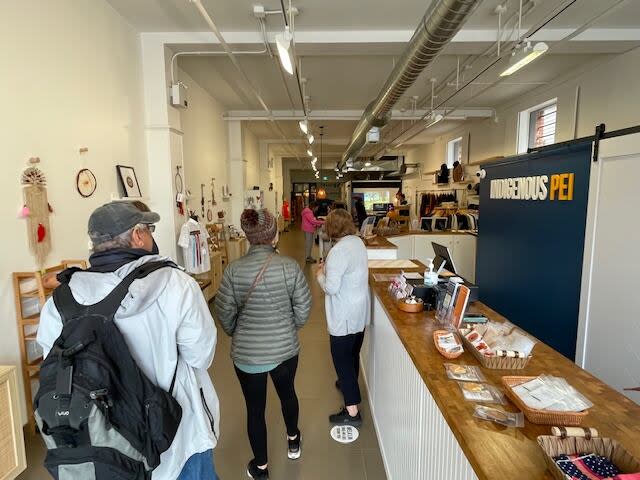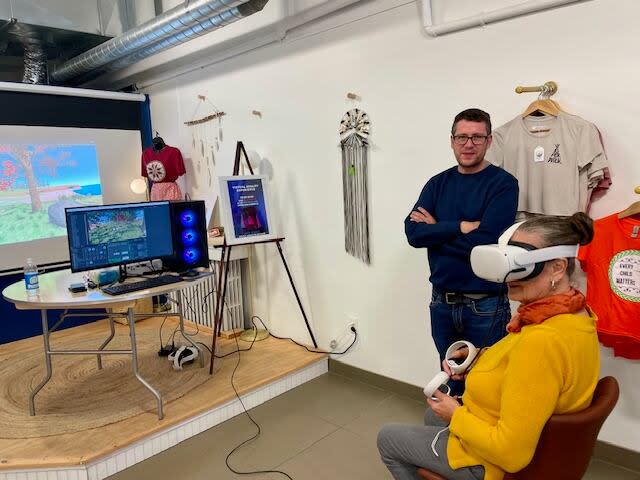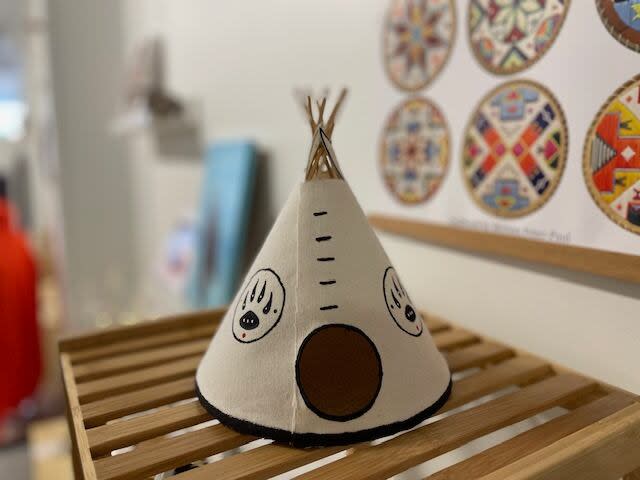Nic Joseph remembers where her love of beading began. She would come home every day after school and see her mother in her “safe space” — watching her TV shows surrounded by beads.
“She would have her plate of beads and just be covered in beads and she would sit there for hours and hours. And I remember feeling like that was my way to connect with her was to sit there.”
Now she is using her own beadwork to connect with visitors to the P.E.I. Indigenous Store on Grafton Street in Charlottetown. For her and more than 50 other Indigenous artists, it has become their own safe space to share their culture.

Visitors to the store are encouraged to ask questions and make a connection with the art. (Sarah Keaveny-Vos/CBC)
If they make a sale, great. If they can educate the public a little while they’re at it, even better.
“We want to create a safe space for people to ask questions and for people to interact with our pieces,” Joseph said.
“And we encourage curiosity and there’s no wrong questions.”


Jay King, a digital animation designer, watches as a visitor tries his new virtual reality game, First World. (Sarah Keaveny-Vos/CBC)
Every Wednesday until the end of October, a different artist will set up a demonstration in the store. It gives visitors a chance to interact with the artists. There was basket-weaving, and recently Joseph did a beading workshop.
Last Wednesday, Jay King was demonstrating his new virtual reality game, First World. It shows gamers how the Mi’kmaq lived hundreds of years ago, before European settlers arrived.
There were wolves, bears, moose and other animals you won’t see today. And trees that were 1,000 years old.
“They’re 100 feet tall and they’ve been deforested. None of them exist anymore,” King said. “And that’s kind of what I’m trying to showcase in this VR game.”


Most of the pieces are made by artists from P.E.I. (Sarah Keaveny-Vos/CBC)
Gary Webber, a cruise passenger from Georgia, was impressed with King’s demo. He joked that he didn’t expect to get “attacked” by a wolf while he was there, but he sees the game, and the other displays, as valuable teaching tools for a new generation.
“I just got my fingers crossed that maybe these artists can bring them into a world that’s a little bit safer and saner, more inclusive, more compassionate.”
Joseph, who is also the tourism development officer for the Indigenous Tourism Association of Prince Edward Island, said the store gives artists confidence and pride.
“They walk through these doors and they get to see their art on our displays and just to see their faces light up,” she said.
“We try to really encourage them and let them know, like, this is their space, this is their story. They get to do things on their terms. Whatever they’re not comfortable with, whatever they are comfortable with, we want to meet them there.”
And as for the visitors, if they don’t leave with a pair of beaded ear rings, a dream catcher or other piece of art, she hopes they at least felt a connection with Indigenous culture.
“I hope that they can take away a sense of community and obviously more knowledge of the Mi’kmaw people here in Prince Edward Island and that we’ve created a space in them that they don’t fear asking questions, and they go out on their own and they seek more knowledge.”

